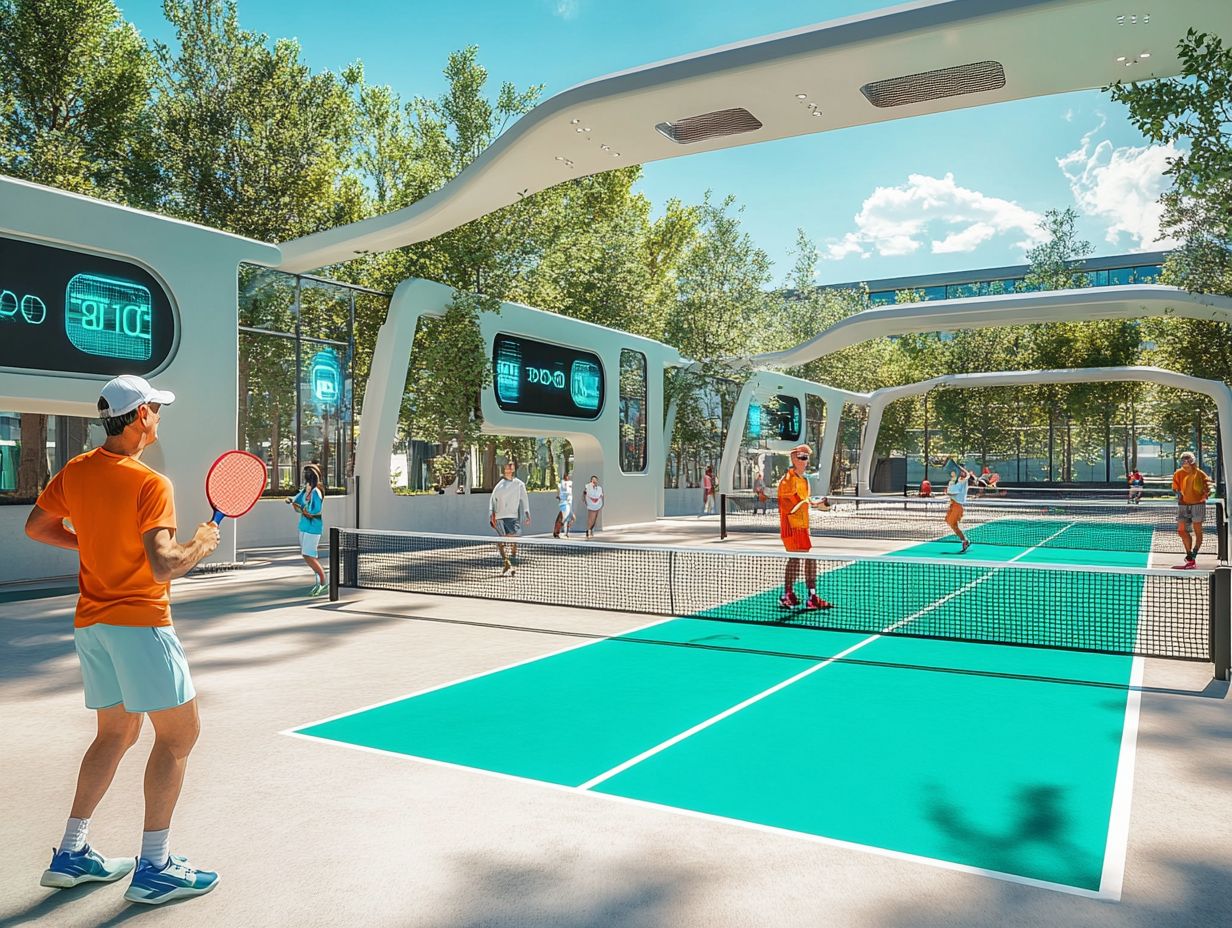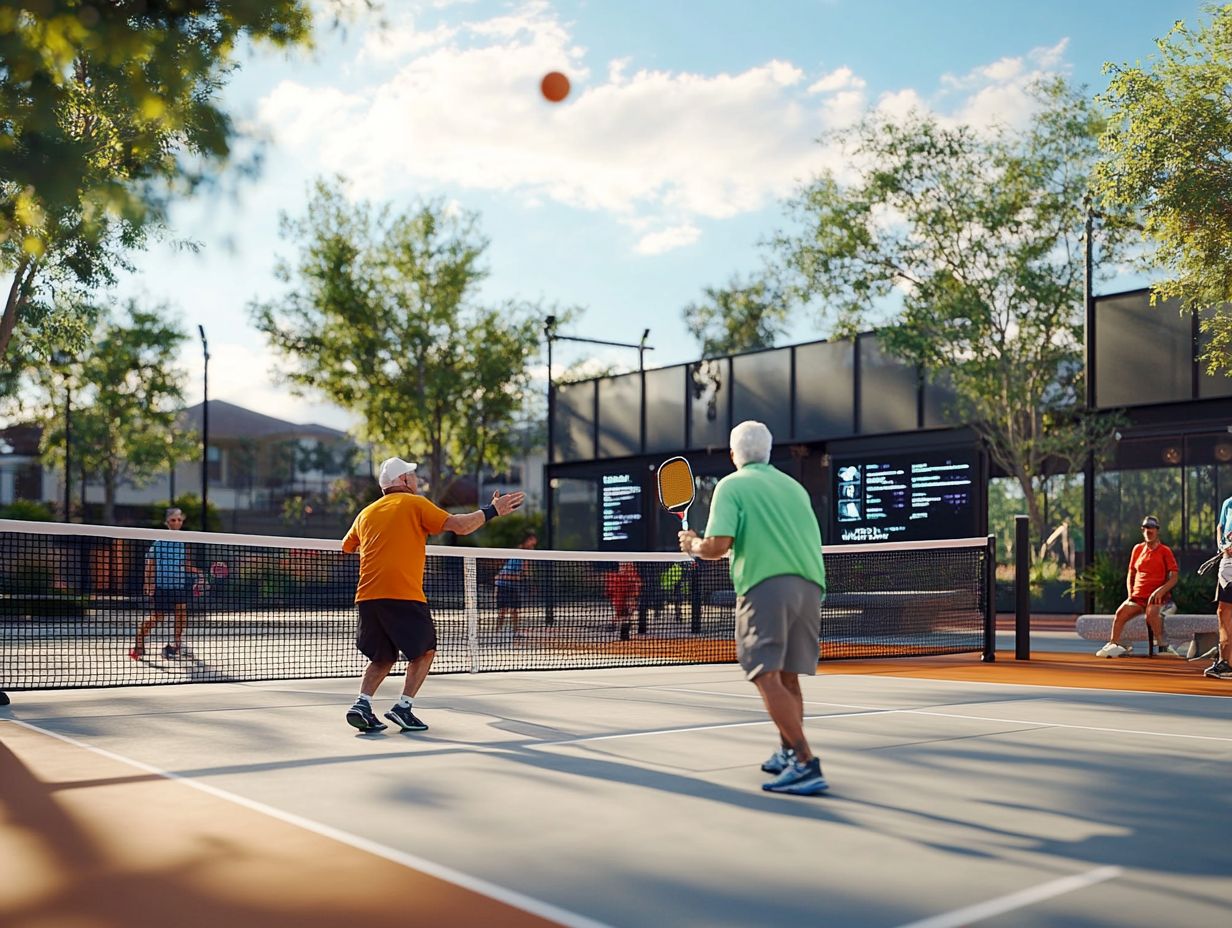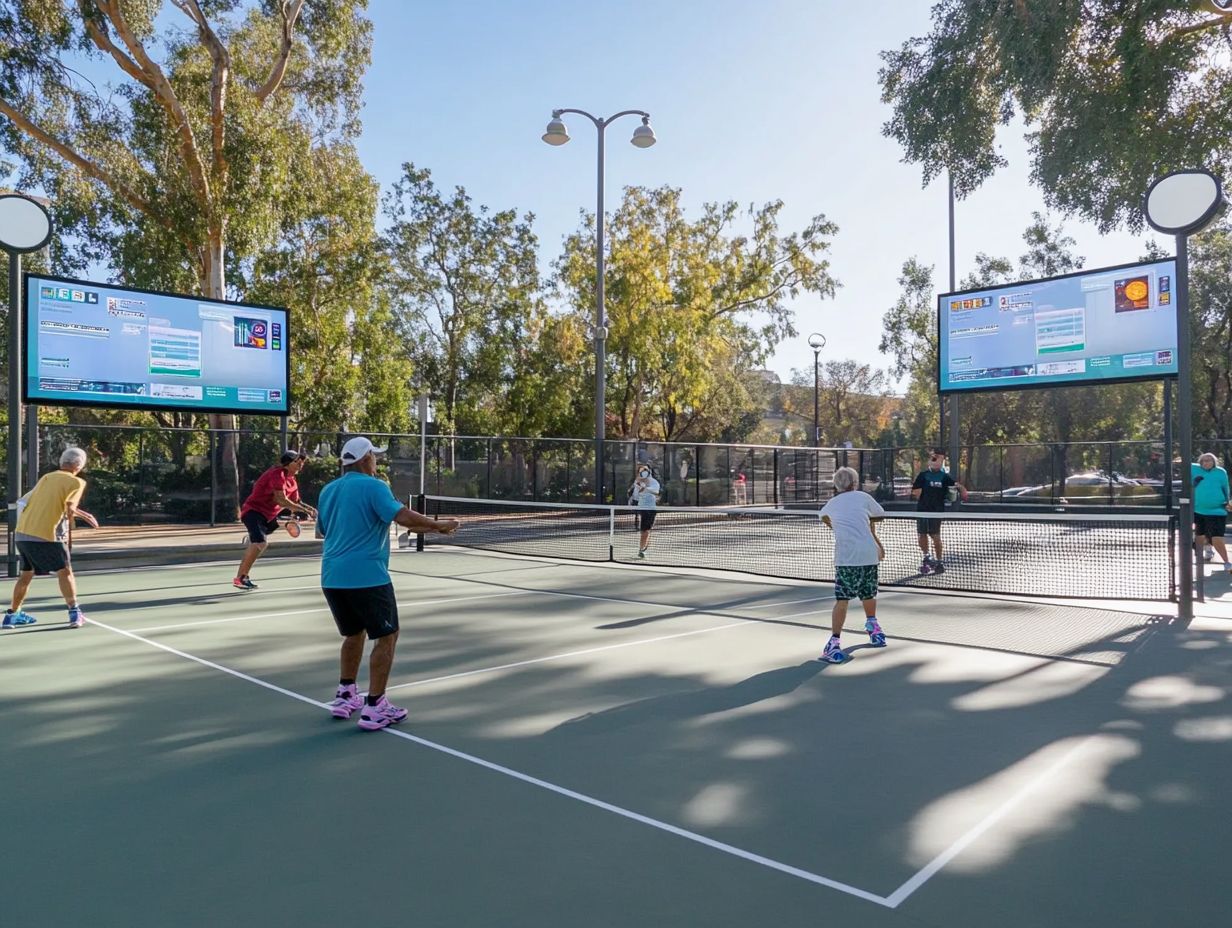Pickleball has quickly become one of the most popular sports in recent years, attracting players of all ages due to its unique combination of fun and competition.
In this article, we explore the factors fueling its growth, the trends that are shaping its future, and the challenges it encounters.
We will discuss innovative changes in gameplay and the potential for pickleball’s inclusion in major sporting events, highlighting what the future holds for this beloved sport.
Join us as we examine the exciting possibilities that technology and new formats may introduce to the world of pickleball.
What is Pickleball?

Pickleball is a paddle sport that combines elements of tennis, badminton, and table tennis, making it accessible for individuals of all ages and skill levels. Invented in the mid-1960s, pickleball has since evolved into a popular recreational activity known for its unique blend of strategy and social interaction.
As the sport has expanded, it has cultivated a close-knit community that values inclusivity and fosters a culture of friendly competition among participants, making it a cherished pastime worldwide. The game features easy-to-understand rules and requires minimal equipment, typically consisting of a paddle and a lightweight plastic ball with holes, which facilitates simple setup and play in various environments.
Its adaptability, allowing for both indoor and outdoor play, has attracted a wide range of participants, from families seeking weekend activities to seniors looking for an enjoyable way to exercise. Numerous organizations have embraced pickleball by organizing tournaments and leagues, further enriching the sense of camaraderie among players while helping to develop the skills and techniques essential for mastering this engaging sport.
Current State of Pickleball
Pickleball is currently one of the fastest-growing sports in the United States and worldwide, experiencing a remarkable surge in popularity. The number of dedicated pickleball facilities and clubs continues to rise, attracting players from diverse demographics who are eager to engage in both competitive and recreational play.
The expanding pickleball community is supported by numerous tournaments and organized leagues that enhance player skills and provide opportunities for social interaction, further increasing the sport’s appeal.
Growth and Popularity
The growth and popularity of pickleball have been driven by a confluence of trends that highlight its health benefits, social engagement, and competitive spirit. As more players discover the sport’s accessibility and enjoyment, youth participation has surged, leading to a growing interest in development programs aimed at nurturing young talent.
This increased engagement has resulted in the expansion of pickleball leagues and events, further cementing its status as a mainstream recreational activity for all ages. The dynamic nature of pickleball appeals to a wide range of demographics, from families seeking shared activities to retirees looking for low-impact exercise.
Community initiatives are crucial, with many local organizations launching free clinics and events to attract participants of all skill levels. The rise of major tournaments has not only increased visibility but also created opportunities for emerging players to showcase their skills.
This surge in organized play fosters an environment that encourages both competition and camaraderie, enriching the community and enhancing the overall experience of the sport.
Current Trends and Challenges
As pickleball continues to gain popularity, current trends highlight both exciting opportunities and unique challenges that the sport must address. The rise of competitive pickleball has spurred innovative approaches to gameplay and coaching while cultivating a vibrant pickleball culture that emphasizes community and shared experiences.
However, critical challenges persist, including maintaining access to facilities, addressing equipment needs, and ensuring inclusivity, all of which are essential for creating a sustainable environment for players from diverse backgrounds.
The integration of technology into gameplay has emerged as a significant trend, with advancements ranging from high-performance paddles to apps that facilitate tournament organization. These innovations make the sport more appealing to tech-savvy younger generations.
Additionally, community events such as local tournaments and social play sessions have become commonplace, fostering stronger connections among players and promoting inclusivity.
Nevertheless, as demand for the sport surges, challenges arise in securing adequate facilities, particularly in urban areas where space is limited. This limitation can impact participation rates and community engagement.
Predictions for the Future of Pickleball

Future predictions for pickleball indicate trends that will transform how the game is played and experienced. One significant trend is global expansion, as more countries begin to adopt pickleball as a mainstream leisure activity.
Additionally, the sport’s accessibility is expected to result in higher participation rates among diverse demographics. These developments will contribute to the enhancement of pickleball facilities and equipment, as well as foster greater interaction within the pickleball community.
Expected Growth and Expansion
The anticipated growth and expansion of pickleball are set to usher in a transformative era for the sport, reflecting an increasing interest in both recreational and competitive play. As participation rates rise, particularly among youth and diverse demographics, the establishment of new leagues and tournaments is expected to provide more opportunities for players to showcase their skills.
This growth will likely enhance the overall accessibility of pickleball and foster the development of more inclusive environments that cater to all players. As communities recognize the potential of pickleball to promote social interaction and active lifestyles, the infrastructure supporting the sport is likely to thrive.
An influx of dedicated courts, community centers, and recreational facilities will emerge, making it easier for enthusiasts to engage without barriers. As local and national competitions become more prevalent, they will generate excitement and inspire further participation.
This competitive aspect, coupled with strong community involvement, will cultivate a vibrant pickleball culture that attracts players of varying skill levels, reinforcing the sport’s growing appeal.
Innovations and Changes in the Sport
Innovations and changes in pickleball fields play a crucial role in shaping the future of the sport, often driven by technological advancements and a growing emphasis on player development. The introduction of state-of-the-art pickleball equipment and improved coaching techniques enhances the level of play while fostering a deeper understanding of the game. As technology continues to influence pickleball, players are experiencing more immersive opportunities to refine their skills and engage in novel ways.
The pickleball landscape is evolving rapidly, with manufacturers releasing lightweight paddles that offer increased power and control, along with high-performance balls designed for enhanced flight and durability. Coaches are now utilizing data analytics to create training programs tailored to each player’s unique strengths and weaknesses, providing a level of individualized attention that was previously unattainable. Additionally, immersive technologies such as augmented reality are offering players unique training sessions that simulate real-game scenarios, making practice more enjoyable.
These innovations not only refine the technical aspects of the game but also cultivate a community of well-rounded athletes who are eager to improve and derive greater enjoyment from the sport.
Possibilities for Pickleball’s Evolution
The potential for the evolution of pickleball is vast, with innovative gameplay and community engagement adaptations that could reshape the sport’s landscape.
As pickleball continues to grow, incorporating adaptive formats will ensure that players of all abilities can participate, fostering an inclusive environment that celebrates the sport’s diversity.
Innovations in gameplay and equipment are expected to further enhance pickleball culture, creating a dynamic community that embraces change and welcomes new participants.
New Formats and Variations

New formats and variations of pickleball are emerging, enhancing the excitement of the sport and attracting players from diverse backgrounds. These innovations, ranging from different types of mixed doubles to team-based competitions, offer greater flexibility and adaptability in how pickleball is played, fostering engagement among recreational sports enthusiasts. As these new formats gain popularity, the pickleball community has the opportunity to enrich its culture and improve player experiences across various styles of play.
New Formats and Variations of Pickleball
Round-robin Competitions:
Similar to league play in other sports, round-robin competitions allow participants to compete in multiple games against different opponents over a defined period, typically a few days. This format ensures that all players get ample opportunities to participate and meet fellow enthusiasts. It is particularly beneficial for less experienced players, as it provides several matches without the pressure of a knockout tournament, which may end after just one or two games.
Themed Tournaments:
Many regions are experimenting with themed tournaments that add a social element to the sport. These events can include costume competitions, holiday-themed gatherings, and other activities that encourage players to socialize between games. Additionally, themed tournaments often serve as fundraising events for local charities and organizations.
Team-based Tournaments:

In these competitions, two or more teams compete against one another, usually following a round-robin format. Team members can possess varying skill levels, which helps balance the competition against more experienced opponents. These tournaments also promote social interaction and camaraderie, as teams often plan fun activities surrounding their matches.
Another notable trend among pickleball organizations is the creation of leagues that focus exclusively on either singles or doubles play. This approach allows for more targeted skill development for players who prefer one format over the other. Numerous other innovations are being proposed and tested within the pickleball community, as local recreational leagues remain open to creative changes suggested by players with experience in other sports.
Engaging the Community
Overall, these new formats and variations deepen participants’ engagement with the sport beyond the physical activity itself. Local challenges, competitions, and leagues serve as excellent opportunities for players to meet new people and strengthen bonds with existing friends. Competitions allow players to showcase their skills and develop new ones in front of a supportive audience, fostering a sense of connection to the sport that transcends mere participation. As players develop a healthy sense of pride and attachment to their local leagues, this engagement becomes a crucial stepping stone for potential success in larger competitions.
Many athletes in various sports have risen through local leagues to attract the attention of scouts and eventually compete at the highest levels. There is no reason this trend cannot also occur in pickleball, making the establishment of local competitions with new formats and variations an important step in that direction.
Inclusion in Major Sporting Events
The inclusion of pickleball in major sporting events marks a significant milestone for the sport, highlighting its rising prominence in the global sports landscape. With increased media coverage and the attention of pickleball organizations, competitive leagues are emerging that offer exciting tournament opportunities for players of all skill levels.
This recognition not only enhances the visibility of pickleball but also fosters a sense of community among participants eager to showcase their talents on larger platforms. As these tournaments gain popularity, they attract a diverse audience, creating a vibrant atmosphere that encourages more individuals to get involved.
Media coverage plays a crucial role in this growth by providing insights into match highlights, player interviews, and expert commentary, which can spark interest among potential newcomers. The involvement of prominent leagues and organizations not only legitimizes the sport but also creates pathways for grassroots movements that cultivate local engagement.
These dynamics contribute to a thriving pickleball culture, enhancing participation rates and solidifying the sport’s position in the competitive landscape.
Impact of Technology on Pickleball
Technology has a significant impact on pickleball, introducing numerous innovations that enhance gameplay and improve player experiences.
These advancements encompass state-of-the-art pickleball equipment designed to help players perform at their best, as well as analytics tools that enable players to analyze and refine their gameplay strategies.
As these technological innovations continue to transform and elevate the sport, the future of pickleball looks promising, offering many opportunities for growth and development.
Advancements in Equipment and Training
Improvements in pickleball equipment and training methods are crucial for enhancing player performance and enjoyment of the sport. The availability of high-quality paddles, balls, and court designs for all skill levels has transformed how players engage with the game. Alongside innovative coaching methodologies and fitness programs, these advancements have established a more efficient pathway for player development, allowing talent to be discovered and a love for the game to flourish.
Data-driven training methods enable coaches to assess player performance in real time, facilitating the quick identification of strengths and weaknesses in ways that were previously impossible. This analytical approach, combined with increased community involvement through local leagues and workshops, not only motivates players to improve their skills but also fosters friendships among participants.
Additionally, fitness programs that emphasize agility and endurance have become standard, further enhancing athleticism on the court. As a result, players are increasingly able to push their limits, creating a more dynamic and exciting environment that encourages lifelong participation in the game.
Integration of Virtual and Augmented Reality
The integration of virtual and augmented reality in pickleball has revolutionized the way players engage with the sport by offering immersive experiences that enhance both training and competitive environments. These technologies create an interactive platform where players can analyze their gameplay and develop their skills in a dynamic setting.
By using virtual and augmented reality, pickleball players can simulate various game scenarios and refine their strategies without the limitations of physical space. Additionally, these platforms enable coaches to monitor players’ real-time performance and provide immediate feedback on specific skills that need improvement.
The social features inherent in these virtual and augmented environments foster a community of players who can connect with one another, sharing interests that enhance both learning and enjoyment of the game. Consequently, the future of training and gameplay in pickleball is filled with limitless opportunities for growth and development.

Pickleball’s more than a game to me—it’s a passion. I write, sharing its highs and lows, the thrills and the lessons. Some tales might draw you to the court, while others give a hint of the game’s magic. So, curious about my journey? Ready to dive deep into the world of pickleball with me? Let’s go.
